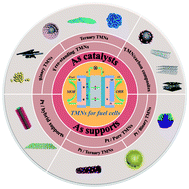Recent advances in nanostructured transition metal nitrides for fuel cells
Abstract
Fuel cells are considered renewable and clean energy sources to replace the dwindling fossil fuel resources. However, the sluggish reaction kinetics of the anodic fuel oxidation and cathodic oxygen reduction reactions hinder the wide commercialization of fuel cells. The Pt/C material is still the most efficient electrocatalyst; however, its high price and poor stability severely impede its large-scale application. Recently, transition metal nitrides (TMNs) have been regarded as promising electrocatalyst materials owing to their unique physical, chemical, and electronic properties, e.g., thermal stability, metallic conductivity, great hardness, and corrosion resistance. Herein, the advances pertaining to TMN-based catalyst materials for fuel cells are reviewed, ranging from their structures, properties, and synthesis to their applications. TMNs can act as catalysts or supports in electrocatalytic processes. Briefly, as catalysts, TMNs are grouped into free-standing TMNs (including binary and ternary TMNs) and TMN/carbon composites. Moreover, as supports, TMNs can be categorized as pure TMNs supports and hybrid supports to anchor noble metals. Finally, the challenges and perspectives of TMN-based catalyst materials for high-performance fuel cell systems are discussed.

- This article is part of the themed collection: Journal of Materials Chemistry A Recent Review Articles


 Please wait while we load your content...
Please wait while we load your content...